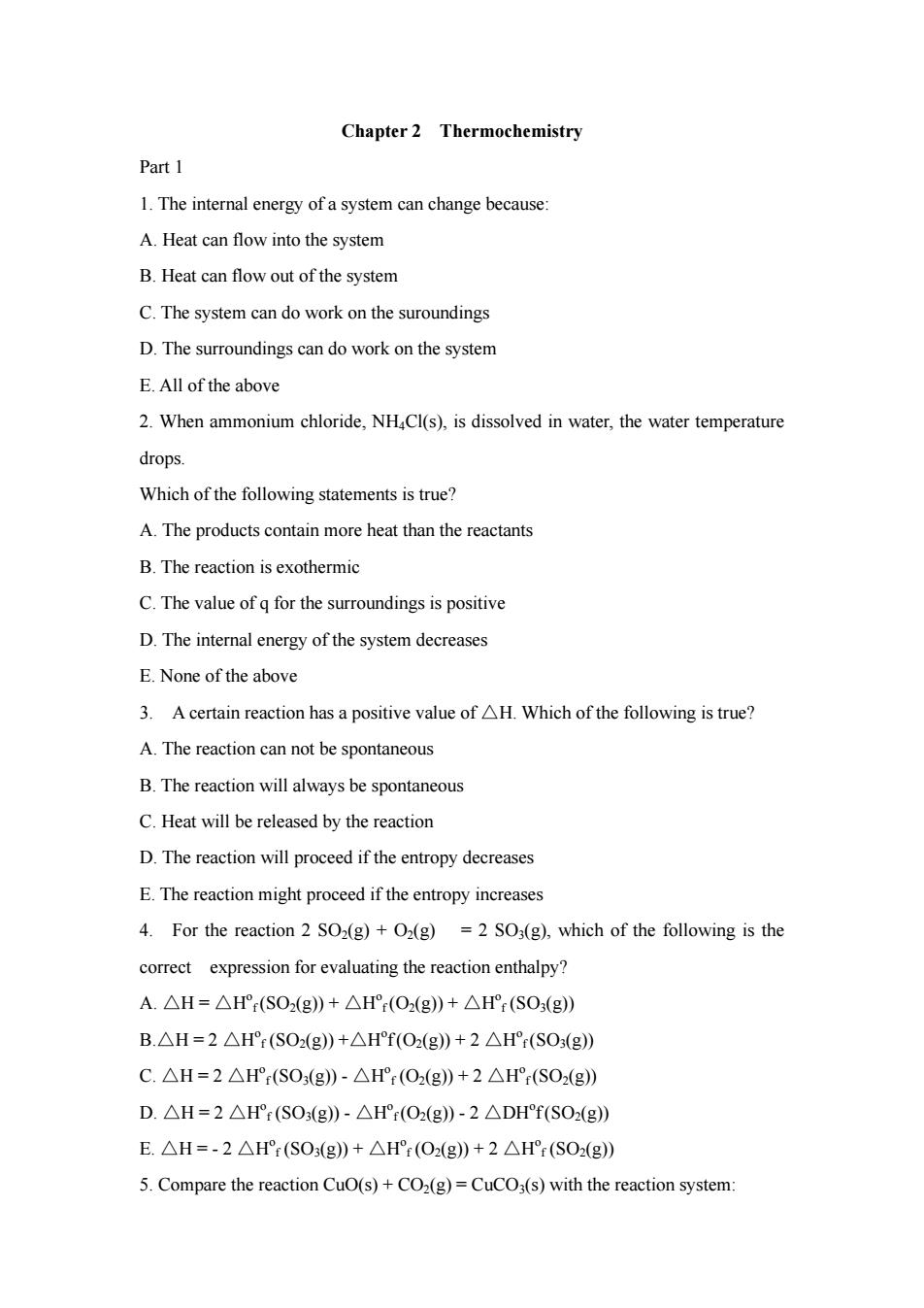正在加载图片...

Chapter2 Thermochemistry Part 1 1.The internal energy ofa system can change because A.Heat can flow into the system B.Heat can flow out of the system C.The system can do work on the suroundings D.The surroundings can do work on the system E.All of the above 2.When ammonium chloride,NHCl(s).is dissolved in water,the water temperature drops. Which of the following statements is true? A.The products contain more heat than the reactants B.The reaction is exothermic C.The value ofq for the surroundings is positive D.The internal energy of the system decreases E.None of the above 3.Acertain reaction has a positive value of H.Which of the following is true? A.The reaction can not be spontaneous B.The reaction will always be spontaneous C.Heat will be released by the reaction D.The reaction will proceed if the entropy decreases E.The reaction might proceed if the entropy increases 4.For the reaction 2 SOx(g)+O(g)=2 SO3(g).which of the following is the correct expression for evaluating the reaction enthalpy? A.△H=△HF:(SO(g)+△H(O(g)+△H:(S0(g) B.△H=2△H°(SO2(g)+△Hf(O2(g)+2△H(SO(g》 C.△H=2△H(S0(g)-△H(O2(g》+2△HF(S02(g) D.△H=2△H:(SO(g)-△H(O2(g)-2△DHf(S02(g) E.△H=.2△H:(S0(g》+△H:(O2(g)+2△H:(S02(g) 5.Compare the reaction CuO(s)+CO2(g)=CuCO3(s)with the reaction system: Chapter 2 Thermochemistry Part 1 1. The internal energy of a system can change because: A. Heat can flow into the system B. Heat can flow out of the system C. The system can do work on the suroundings D. The surroundings can do work on the system E. All of the above 2. When ammonium chloride, NH4Cl(s), is dissolved in water, the water temperature drops. Which of the following statements is true? A. The products contain more heat than the reactants B. The reaction is exothermic C. The value of q for the surroundings is positive D. The internal energy of the system decreases E. None of the above 3. A certain reaction has a positive value of △H. Which of the following is true? A. The reaction can not be spontaneous B. The reaction will always be spontaneous C. Heat will be released by the reaction D. The reaction will proceed if the entropy decreases E. The reaction might proceed if the entropy increases 4. For the reaction 2 SO2(g) + O2(g) = 2 SO3(g), which of the following is the correct expression for evaluating the reaction enthalpy? A. △H = △Ho f (SO2(g)) + △Ho f (O2(g)) + △Ho f (SO3(g)) B.△H = 2 △Ho f (SO2(g)) +△Ho f(O2(g)) + 2 △Ho f (SO3(g)) C. △H = 2 △Ho f (SO3(g)) - △Ho f (O2(g)) + 2 △Ho f (SO2(g)) D. △H = 2 △Ho f (SO3(g)) - △Ho f (O2(g)) - 2 △DHo f(SO2(g)) E. △H = - 2 △Ho f (SO3(g)) + △Ho f (O2(g)) + 2 △Ho f (SO2(g)) 5. Compare the reaction CuO(s) + CO2(g) = CuCO3(s) with the reaction system: